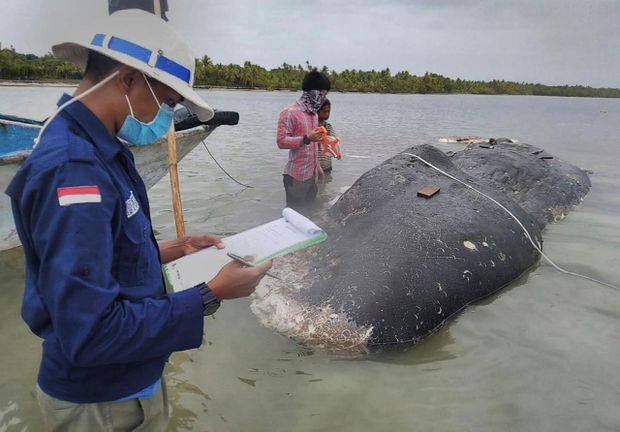(单词翻译:单击)
Hi everyone, for this week, Seeker is continuing our collaboration with The Swim to raise awareness about ocean health.
大家好,这周,我们《科学探索之旅》频道将继续与“环游太平洋”合作,唤醒人们对海洋健康的意识。
And Ben Lecomte has already seen a lot of plastic on his journey.
到目前为止,本·勒康特已经在他的环游太平洋之旅中看到了很多塑料。
Plastic is a material that’s cheap, versatile, and lightweight.
塑料是一种便宜、用途广泛而且轻便的材料。
It is also a major source of ocean pollution,
但也是海洋污染的主要来源之一,
which we’re reminded of every time a dead whale washes ashore with one hundred and fifteen plastic cups in its stomach.
每当一条胃里装着115个塑料杯的鲸鱼尸体被冲上岸时,我们就会回想起这一点。
So who is most responsible for all this pollution, and why?
那么,究竟谁才是所有这些污染的罪魁祸首呢?为什么?
At first glance, the numbers seem to point the finger at a handful of countries in Asia.
初看之下,有关数据似乎把矛头指向了少数几个亚洲国家。
A 2015 study named the five biggest contributors,
因为2015年的一项指出了五位最主要的污染制造者,
which were Sri Lanka, Vietnam, the Philippines, Indonesia, and topping the charts at number 1 by a wide margin, China.
这些国家包括斯里兰卡、越南、菲律宾、印度尼西亚,以及遥遥领先的中国。
Much of the plastic pollution from these countries stemmed from underdeveloped waste management systems.
这些国家的塑料污染大多来源于废物管理系统的落后。
In China, 76% of waste was mismanaged,
在中国,76%的垃圾都没有得到恰当的处理,
meaning it was either just dropped as litter
也就是说,那些垃圾要么被直接丢掉,
or disposed of in dumps or landfills that weren’t well contained and allowed the plastic to escape.
要么被弄到了固定条件不是很好的垃圾场或填埋场,最终导致塑料泄露了出去。
The study concluded that all that mismanaged plastic
这项研究的结论是,所有这些管理不当的塑料
ended up depositing between 1.3 and 3.5 million metric tons of debris in the ocean each year,
最终都会以每年130万公吨到350万公吨的速度沉积到海里,
almost a third of the estimated annual marine plastic scrap.
占到了海上塑料废弃物估计年增长量的将近三分之一。
But don’t be so quick to pin all the blame on China.
不过,大家不要急于把所有的责任都推到中国身上。
Starting in 1992 China started importing plastic waste from other countries,
因为从1992年开始,中国就已开始从其他国家进口塑料垃圾,
and it’s bought up a total of about 45% of the post-consumer plastic exported since then,
这些年来中国一共购买了全世界大约45%的消费后出口塑料,
adding about 10 to 13 percent to their domestic waste.
使得中国国内的垃圾规模增加了10%~13%。
Why? Because that plastic can be processed and turned into other goods.
为什么?因为塑料可以被加工成其他产品。
Well, some of it can anyway.
好吧,反正有些是可以的。
Not all plastics are created equal, and some types of plastic are more easily recycled than others.
并不是所有的塑料都是一样的,有些类型的塑料会比其他类型更容易回收。
You may have noticed the recycling symbol on your plastic products has a number between 1 and 7 in the middle.
你可能已经注意到了,我们使用的塑料制品上的回收标志中间有一个位于1~7之间的数字。
Those numbers actually tell you what kind of plastic the product is made from,
这些数字实际上能告诉我们产品是由哪种塑料制成的,
and some types are easier to recycle than others.
而有些类型比其他类型更容易回收利用。
The two most common types of recycled plastic are polyethylene terephthalate, found in clothes and disposable bottles;
最常见的两种可回收塑料是生产衣服和可回收塑料瓶所用的聚对苯二甲酸乙酯(PET)塑料;
and high-density polyethylene, found in detergent bottles, milk jugs, and toys.
和洗涤剂瓶,牛奶壶,和玩具所用的高密度聚乙烯。
Those are numbers one and two, but plastics labeled 3 to 7 can be harder to process.
它们分别是1号塑料和2号塑料,但标记为3~7号的塑料就很难处理了。
No matter the number China was accepting it all.
而不管是几号塑料,中国都一律接受了。
Further complicating things is when materials get mixed.
让问题变得更加复杂的是对不同类型的塑料进行的混合。
Single-use coffee cups, for example, often have a thin coating of polyethylene to make them liquid-proof,
例如,一次性咖啡杯内壁通常都有一层薄薄的聚乙烯涂层以使其防水,
which means the materials have to be separated first before they can be recycled.
这就意味着这些材料必须先被分离下来才能对剩下的部分进行回收利用。
The process is difficult and expensive, so most waste management facilities just treat the cups as trash.
这个过程既困难又昂贵,所以大多数废物管理机构都把杯子直接当作垃圾进行处理。
Likewise when single use food containers still have scraps of food or liquid in them,
同样,一次性食品盒中仍有食物残渣或液体的时候,
they can’t be processed either and are just discarded.
也不能进行处理,最后还是被丢掉了。
So since China was buying up nearly half the world’s exported used plastics,
所以,由于中国购买了全世界近半数的出口废旧塑料,
and plenty of that was too difficult or impossible to recycle
而其中有很多都很难回收或完全无法回收,
and was subsequently put into inadequate dumps and landfills,
之后便被投入了不够格的垃圾场和垃圾填埋场,
then some of the responsibility lies with the exporters.
部分责任就因此落在了出口商身上。
At 693 million metric tons, The US was the second biggest seller of plastic to China in 2016,
2016年,美国以6.93亿吨的总量成了中国第二大塑料进口来源,
so even though USA ranked 20th on the list of biggest marine plastic polluters,
所以,尽管美国在海洋塑料污染最严重的国家中排名第20位,
that’s only because we weren’t handling all our trash ourselves.
那也只是因为我们没有自己处理所有的垃圾。
At the start of 2018 though, things changed.
然而,2018年初,情况发生了变化。
Citing environmental reasons, China stopped the import of post-consumer plastics completely.
中国以环境为由彻底停止了对消费后塑料的进口。
The last link in the supply chain just wasn’t accepting our low-quality stuff anymore.
供应链的最后一个环节不再接受我们的低质量产品了。
Other countries like Vietnam, Indonesia, Malaysia and Thailand are buying more plastic,
虽然越南、印度尼西亚、马来西亚和泰国等其他国家还在继续购买我们的塑料垃圾,
but those countries struggle to manage their waste already,
但是这些国家处理他们自己的垃圾都很困难,
so a lot of that plastic will likely find its way to the ocean too.
所以,很多塑料最终可能还是会走向海洋。
Plus, they can never match the market size of China,
此外,那些国家根本无法同中国的市场规模匹敌,
so we still have a lot of trash to deal with all of a sudden.
所以,我们突然就多了很多要自己处理的垃圾。
Our waste management systems weren’t ready for this influx of plastic,
由于我们的废物管理系统还没有准备好迎接这样汹涌而来的大堆塑料,
and much of what we used to send overseas for recycling is heading right to the landfill.
所以,我们过去寄到海外进行回收利用的大部分塑料就直接流向了垃圾填埋场。
So what can an individual like you do
如果你担心塑料会流入海洋,伤害鱼类、海龟和鲸鱼,
if you’re worried about plastic finding its way to the ocean and hurting fish and sea turtles and whales?
那么,像你这样的个人能做点什么呢?
Well lots of thing as it turns out.
事实上,你能做的事有很多。
You can use less plastic, full stop.
你可以少用点儿塑料制品,就是这样。
You can recycle more, and be better at recycling too
多回收,并且通过清洗用过的塑料,
by rinsing your used plastics and being aware of what plastics your local recycling facility can handle.
了解你所在的地区的回收设施可以处理哪些塑料来让自己更有效地回收。
And you can demand that manufacturers use more recycled plastics.
你还可以要求制造商使用更多的再生塑料。
Even though the recycling process increases the cost,
即使回收过程会增加成本,
some companies are planning to make more products with recycled materials because it’s important to their consumers.
但一些公司已经开始计划用回收材料生产更多的产品,因为这对他们的消费者很重要。
And lastly, just don’t litter.
最后,不要乱扔垃圾。
It’s the laziest crime.
乱扔垃圾是最懒惰的罪行。
Do it for the turtles.
就算是为了海龟们,请不要乱扔垃圾。
Are you surprised by how much plastic gets mismanaged?
你是不是对竟然有那么多塑料处理不当感到很惊讶?
If you have some helpful tips, why don’t you share them down in the comments.
如果你有一些有用的建议,何不在下面的评论中分享给我们呢?
Seeker is highlighting The Swim for the rest of this week to bring awareness to the impact of pollution
本周剩下的时间里,《科学探索之旅》还会继续聚焦“环游太平洋”,以求唤醒人们对污染对我们的影响的意识,
since it’s one of the most important issues facing humanity today.
因为污染是当今人类面临的最重要的问题之一。
We ask you to help us spread the message and keep coming back to Seeker for all your environment updates, and thanks for watching.
希望大家能够帮助我们宣传,同时记得回来查看关于环境的内容更新,感谢大家的收看!


